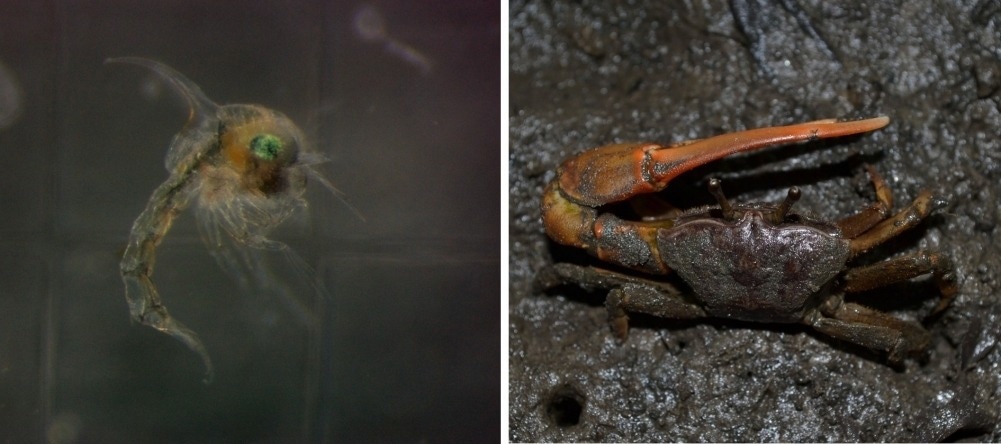According to recent research published in Estuarine, Coastal and Shelf Science by researchers working in Brazil, Norway, and the United States, an increase in marine heatwaves as a result of global climate change in the coming years will have a noticeable impact on lifeforms in the environment, including those at the bottom of the food chain.
 Larvae of the Atlantic mangrove fiddler crab (Leptuca thayeri, left) survived less in warmer water and underwent physiological changes due to higher acidity. On the right, an adult individual. Image Credit: Murilo Marochi.
Larvae of the Atlantic mangrove fiddler crab (Leptuca thayeri, left) survived less in warmer water and underwent physiological changes due to higher acidity. On the right, an adult individual. Image Credit: Murilo Marochi.
Marine heatwaves are described as periods of more than five days with water temperatures more than 90% higher than the region’s historical average. Projections show a 35% increase in the frequency of marine heatwaves by the year 2100 for the Santos-São Vicente area (coast of São Paulo state, Brazil), where the research was carried out.
It is important to differentiate between marine and atmospheric heatwaves, with the latter being more extreme but primarily affecting terrestrial environments, including cities.
Scientists investigated the effects of marine heatwaves on the planktonic larvae of the Atlantic mangrove fiddler crab Leptuca thayeri.
Although the larvae survived a rise in the acidity of the water, a rise of 2 °C in sea surface temperature during the first three to four days of their lives led to a 15% drop in the survival rate compared with larvae at the average temperature for the region. A rise of 4 °C led to a 34% rise in mortality.
Murilo Zanetti Marochi, Study First Author, São Paulo State University
The research was carried out when Marochi was on a postdoctoral research fellowship at the Institute of Biosciences of the São Paulo State University’s Coast Campus (IB-CLP-UNESP) in São Vicente.
The study was conducted in collaboration with Alvaro Montenegro, a professor at Ohio State University in the United States, as part of a project to explore the effects of climate change on estuarine fauna in São Paulo state under the aegis of the FAPESP Research Program on Global Climate Change (RPGCC).
This species is extremely abundant in mangrove forests in the Mar Pequeno estuarine region, where the study was conducted. After the eggs hatch, the larvae stay there for a few days and then migrate to the ocean. Fewer than 1% return to complete their life cycle. Most become food for other species. For this reason, among others, this little crab plays an important role in the ecosystem.
Tânia Marcia Costa, Study Last Author and Professor, Institute of Biosciences, Coast Campus, São Paulo State University
Warmer Future
Costa and Juan Carlos Farias Pardo, then a master’s candidate, previously demonstrated how warming and acidification lowered the survival rate of L. thayeri embryos. The increase in temperature simulated in that research was based on the Intergovernmental Panel on Climate Change (IPCC) forecast for the end of the century.
The recent research, which was also co-signed by Pardo, a Ph.D. candidate at the University of Agder in Norway, found no substantial differences in larva survival due to increasing acidity, but physiological alterations were identified. Marine Ph.D. is anticipated to decline in the decades ahead, affecting numerous species.
Estuaries naturally undergo major variations in acidity, and the species will probably tolerate a rise in this parameter to some extent.
Murilo Zanetti Marochi, Study First Author, São Paulo State University
Marochi is currently associated with the State University of Paraná (UNESPAR) at Paranaguá (Brazil).
High acidity, like higher temperatures, causes physiological stress in crabs by increasing their heart rate and decreasing their mobility.
“They swim less and may not be able to stay in the water layer closest to the surface, where the microalgae they feed on live,” he details.
The consequences of marine heatwaves will be detrimental to the species and those that feed on them, potentially resulting in economic losses to fisheries. However, no research has been done to confirm a decline in L. thayeri stocks over the last 20 years. According to the authors, this could be attributable to other factors that are offsetting the changes.
For example, warmer sea surface temperatures may allow larvae to grow more quickly, rendering them less susceptible to predators and harsh environmental conditions. Temperature rises may also encourage the production of microalgae and microbes, which they and other species feed.
Further research is required to determine whether these effects offset the increase in larval mortality, and if so, how much.
Journal Reference:
Marochi, M. Z., et al. (2022) Marine heatwave impacts on newly-hatched planktonic larvae of an estuarine crab. Estuarine, Coastal and Shelf Science. doi.org/10.1016/j.ecss.2022.108122.
Source: https://agencia.fapesp.br/home/